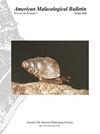入侵的新西兰泥蜗牛(Potamopyrgus antipodarum)的生长速度与以碎屑为基础的饮食相比,以周生植物为基础的饮食增加了。
IF 0.4
4区 生物学
Q4 MARINE & FRESHWATER BIOLOGY
引用次数: 3
摘要
摘要:入侵的新西兰泥螺Potamopyrgus antipodarum (Gray 1843)已经在劳伦森五大湖存在了至少20年。最近,这种蜗牛已经扩散到流入安大略湖的溪流中。在安大略湖的深水中,碎屑是蜗牛的常见食物来源;而在溪流中,浮游植物成为它们饮食的重要组成部分。本实验旨在验证一种假设,即与碎屑相比,以周围植物为食会导致更高的生长速度。在伊利湖18 m深处收集底栖生物沉积物。周生植物生长在宾夕法尼亚州中部春泉溪收集的小岩石上。80只幼螺(体长0.6 ~ 1.0 mm)分别置于塑料杯中,分为4组处理:饲喂螺旋藻粉(实验室标准饲料)的对照螺、湖泊沉积物饲养的对照螺、生长在岩石周围生长的岩石上的对照螺和岩石与湖泊沉积物复合生境的对照螺。六周后,再次测量蜗牛。钉螺的生长速率明显高于其他处理。其他三种处理也导致了同样低的生长率。这些结果表明,当蜗牛从湖泊迁移到溪流环境时,饮食从以碎屑为基础到以植物为基础的变化可能导致更高的个体和可能的种群增长率,从而可能增加它们的入侵成功率。本文章由计算机程序翻译,如有差异,请以英文原文为准。
A Periphyton-Based Diet Results in an Increased Growth Rate Compared to a Detritus-Based Diet in the Invasive New Zealand Mud Snail (Potamopyrgus antipodarum).
Abstract: The invasive New Zealand mud snail, Potamopyrgus antipodarum (Gray 1843), has been present in the Laurentian Great Lakes for at least 20 years. Recently, the snail has spread to streams that empty into Lake Ontario. In the deep waters of Lake Ontario, detritus is the common food source for the snails; while in streams periphyton becomes an important part of their diet. This experiment was designed to test the hypothesis that a diet of periphyton will lead to a higher growth rate compared to detritus. Benthic sediment was collected from 18 m depth in Lake Erie. Periphyton was grown on small rocks collected from Spring Run stream in central Pennsylvania. Eighty juvenile snails (0.6–1.0 mm in length) were placed individually into plastic cups and divided into four treatments: control snails that were fed Spirulina powder (standard lab diet), snails kept in lake sediment, snails reared on rocks with periphyton growth, and snails in a combination habitat of rock and lake sediment. After six weeks, the snails were measured again. Snails in the periphyton-only treatment had a significantly greater growth rate than snails in the remaining treatments. The other three treatments resulted in similarly low growth rates. These results suggest that the change in diet from detritus-based to periphyton-based as the snails move from a lake to a stream environment may result in higher individual and possibly population growth rates, and thus could increase their invasion success.
求助全文
通过发布文献求助,成功后即可免费获取论文全文。
去求助
来源期刊
CiteScore
1.00
自引率
40.00%
发文量
1
审稿时长
>12 weeks
期刊介绍:
The American Malacological Bulletin serves as an outlet for reporting notable contributions in malacological research. Manuscripts concerning any aspect of original, unpublished research,important short reports, and detailed reviews dealing with molluscs will be considered for publication. Recent issues have included AMS symposia, independent papers, research notes,and book reviews. All published research articles in this journal have undergone rigorous peer review, based on initial editor screening and anonymous reviewing by independent expertreferees. AMS symposium papers have undergone peer review by symposium organizer, symposium participants, and independent referees.

 求助内容:
求助内容: 应助结果提醒方式:
应助结果提醒方式:


